PONTIAC GRAND PRIX 2003 Owners Manual
Manufacturer: PONTIAC, Model Year: 2003, Model line: GRAND PRIX, Model: PONTIAC GRAND PRIX 2003Pages: 378, PDF Size: 17.64 MB
Page 301 of 378
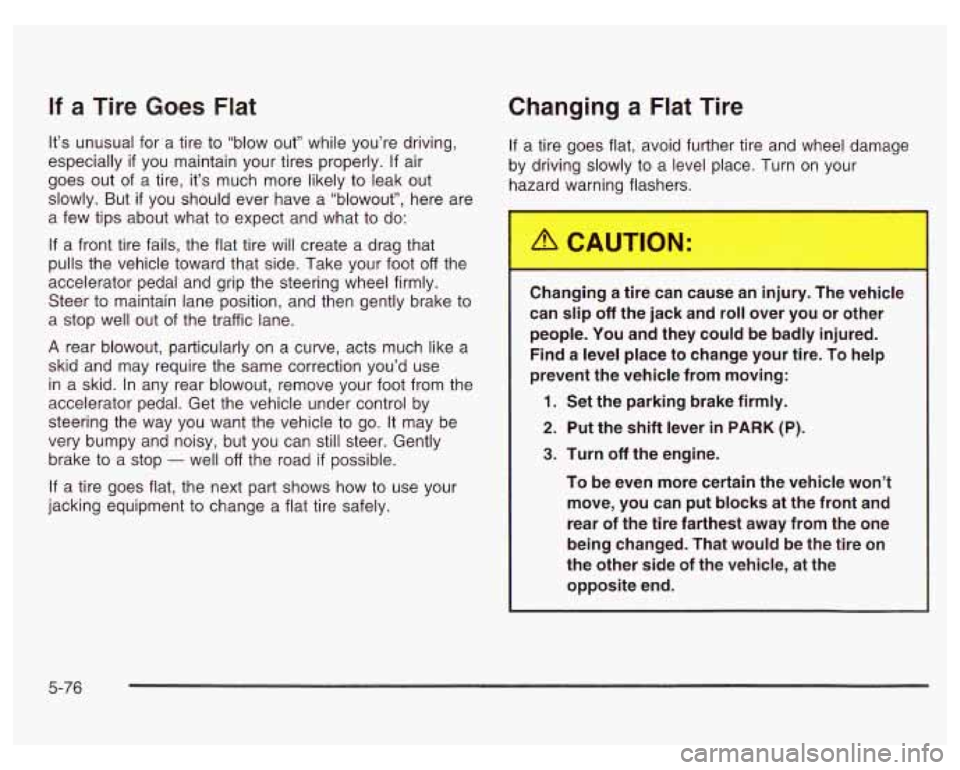
If a Tire Goes Flat
It’s unusual for a tire to “blow out” while you’re driving,
especially
if you maintain your tires properly. If air
goes out of a tire, it’s much more likely
to leak out
slowly. But
if you should ever have a “blowout”, here are
a few tips about what to expect and what to do:
If a front tire fails, the flat tire will create a drag that
pulls the vehicle toward that side. Take your foot
off the
accelerator pedal and grip the steering wheel firmly.
Steer to maintain lane position, and then gently brake to
a stop well out of the traffic lane.
A rear blowout, particularly on a curve, acts much like a
skid and may require the same correction you’d use
in a skid. In any rear blowout, remove your foot from the
accelerator pedal. Get the vehicle under control by
steering the way you want the vehicle to go.
It may be
very bumpy and noisy, but you can still steer. Gently
brake to a stop
- well off the road if possible.
If a tire goes flat, the next part shows how to use your
jacking equipment to change a flat tire safely.
Changing a Flat Tire
If a tire goes flat, avoid further tire and wheel damage
by driving slowly to a level place. Turn
on your
hazard warning flashers.
I
Chant_ g a tire can cause an injury. The v icle
can slip
off the jack and roll over you or other
people.
You and they could be badly injured.
Find a level place to change your tire. To help
prevent the vehicle from moving:
1. Set the parking brake firmly.
2. Put the shift lever in PARK (P).
3. Turn off the engine.
To be even more certain the vehicle won’t move, you can put blocks at the front and
rear of the tire farthest away from
the one
being changed. That would be the tire on
the other side of the vehicle, at the
opposite end.
5-76
Page 302 of 378
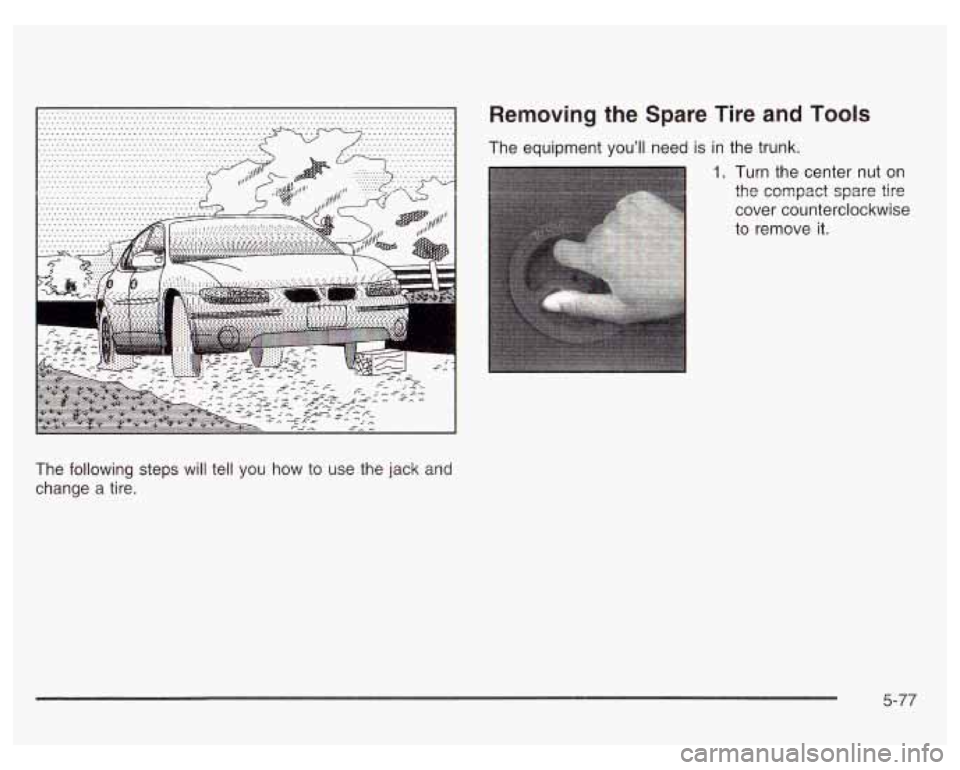
Page 303 of 378
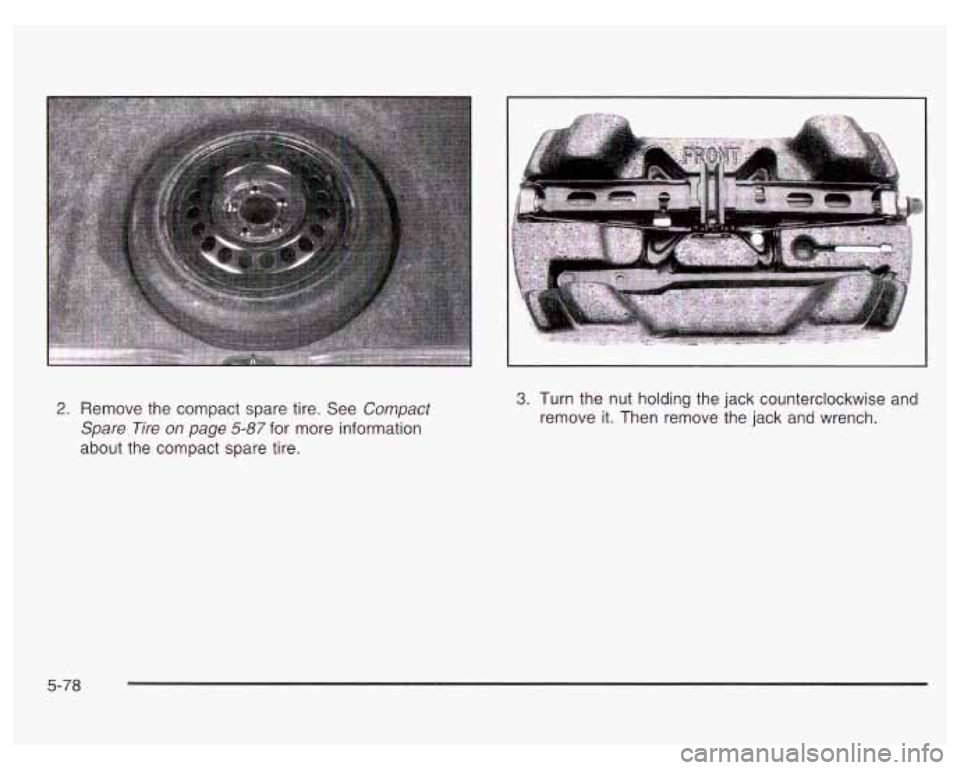
2. Remove the compact spare tire. See Compact
Spare Tire
on page 5-87 for more information
about the compact spare tire.
3. Turn the nut holding the jack counterclockwise and
remove it. Then remove the jack and wrench.
5-78
Page 304 of 378
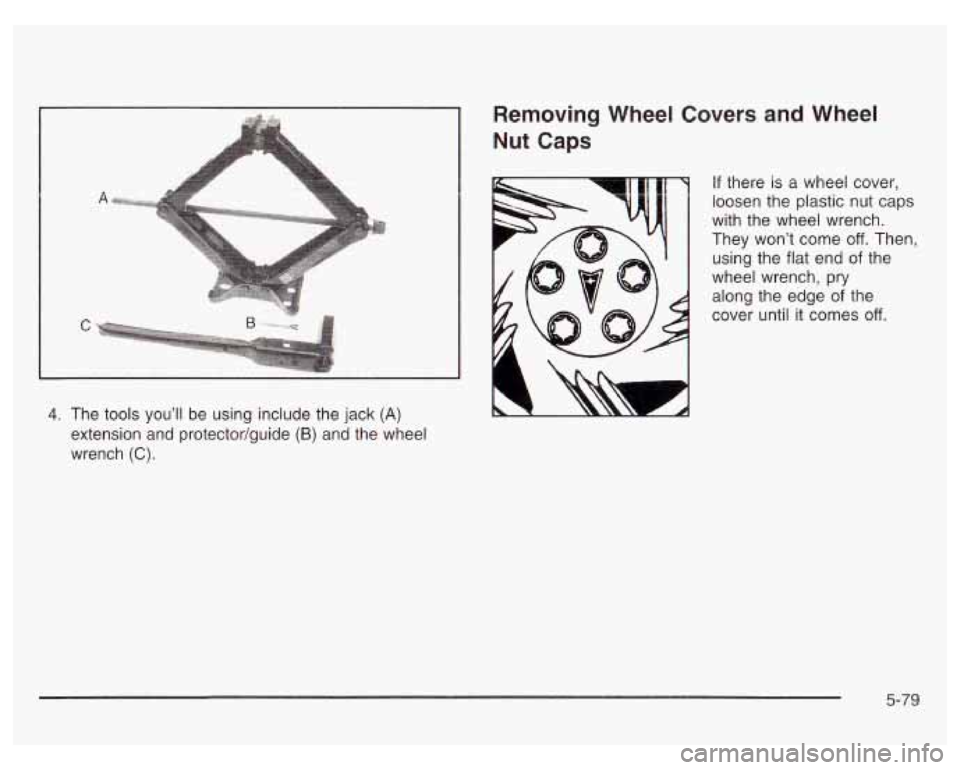
I
4. The tools you’ll be using include the jack (A)
extension and protector/guide (B) and the wheel
wrench
(C).
Removing Wheel Covers and Wheel
Nut Caps
If there is a wheel cover,
loosen the plastic nut caps
with the wheel wrench.
They won’t come
off. Then,
using the flat end of the
wheel wrench,
pry
along the edge of the
cover until it comes
off.
5-79
Page 305 of 378
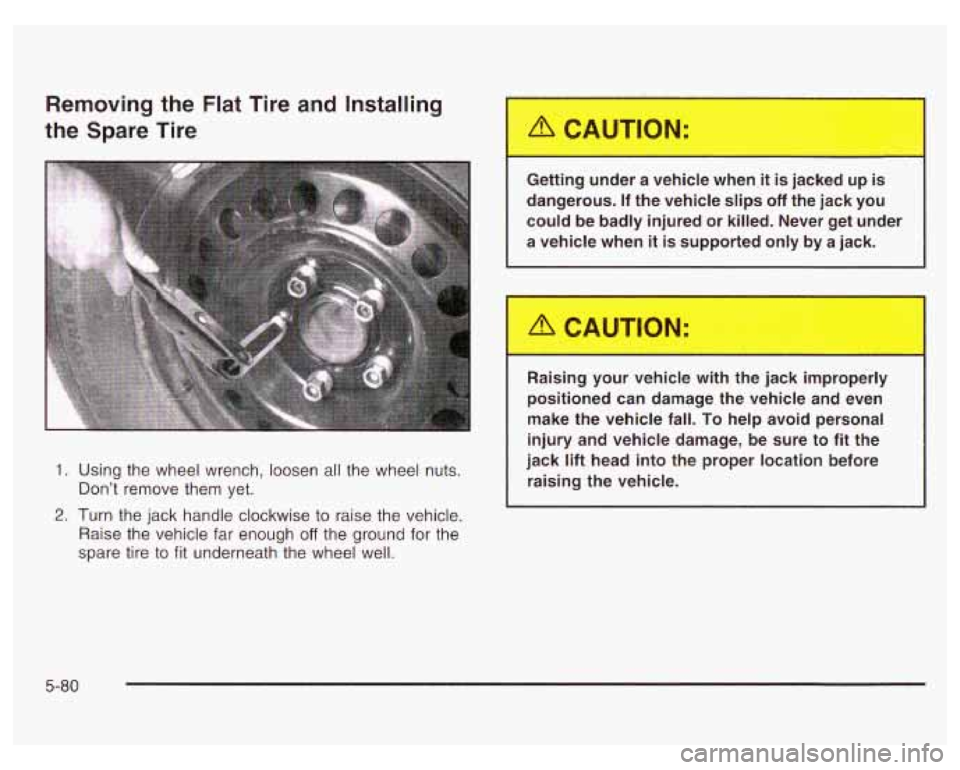
Removing the Flat Tire and Installing
the Spare Tire
1.
2.
Using the wheel wrench, loosen all the wheel nuts.
Don’t remove them yet.
Turn the jack handle clockwise to raise the vehicle.
Raise the vehicle far enough
off the ground for the
spare tire to fit underneath the wheel well. Getting under a vehicle when
it is jacked up is
dangerous. If the vehicle
slips off the jack you
could be badly injured or killed. Never get under
a vehicle when
it is supported only by a jack.
Raising your
v icle with th _ack imp1 -1erly
positioned can damage the vehicle and even
make the vehicle fall.
To help avoid personal
injury and vehicle damage, be sure to
fit the
jack
lift head into the proper location before
raising the vehicle.
5-80
Page 306 of 378

B
For jacking at the vehicle’s front location, put the jack
lift head
(C) about 6 inches (15 cm) from the rear
edge of the front wheel opening
(B) or between the
two bolts
(A) as shown.
Put the compact spare tire near
you.
a- $.>: .............. .... <,..:.:.:.:+:.:.:.’ -7==.== ..............
For jacking at the vehicle’s rear location, put the jack
lift head
(B) about 5.5 inches (14 cm) from the front edge
of the rear wheel opening
(C) or just behind the
off-set
(A) as shown.
Put the compact spare tire near
you.
5-8 1
Page 307 of 378
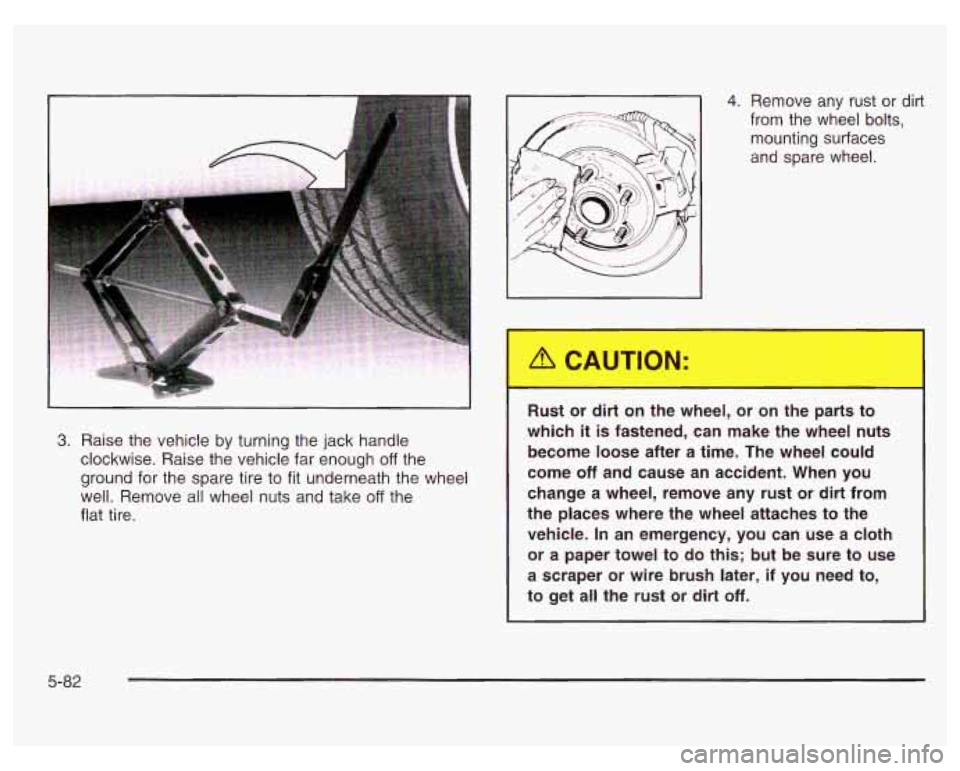
4. Remove any rust or dirt
from the wheel bolts,
mounting surfaces
and spare wheel.
3. Raise the vehicle by turning the jack handle
clockwise. Raise the vehicle far enough
off the
ground for the spare tire to fit underneath the wheel
well. Remove all wheel nuts and take
off the
flat tire.
I
Rust or dirt or. -.le 1 eel, or o parts to
which
it is fastened, can make the wheel nuts
become loose after a time. The wheel could
come
off and cause an accident. When you
change
a wheel, remove any rust or dirt from
the places where the wheel attaches to the
vehicle. In an emergency, you can use a cloth
or a paper towel to do this; but be sure to use
a scraper or wire brush later, if you need to,
to get all the rust
or dirt off.
5-82
Page 308 of 378
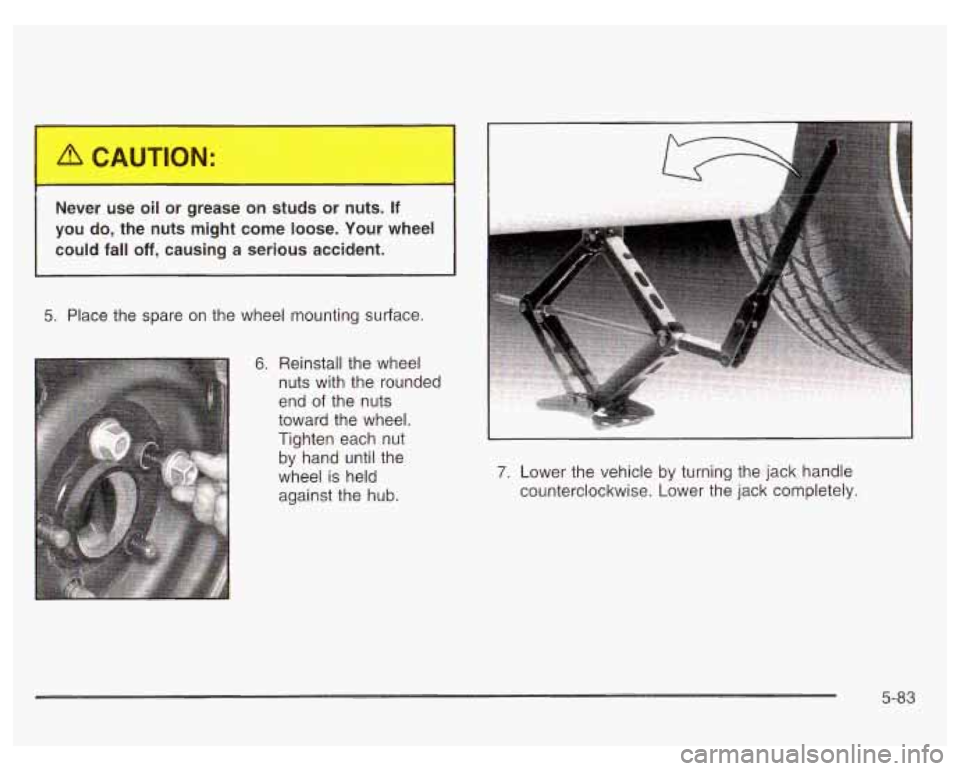
Never use oil or grease on studs or nuts. If
you do, the nuts might come loose. Your wheel
could fall
off, causing a serious accident.
5. Place the spare on the wheel mounting surface.
6. Reinstall the wheel
nuts with the rounded
end
of the nuts
toward the wheel.
Tighten each nut
by hand until the
wheel
is held
against the hub. 7. Lower the vehicle by turning the jack handle
counterclockwise. Lower the jack completely.
5-83
Page 309 of 378
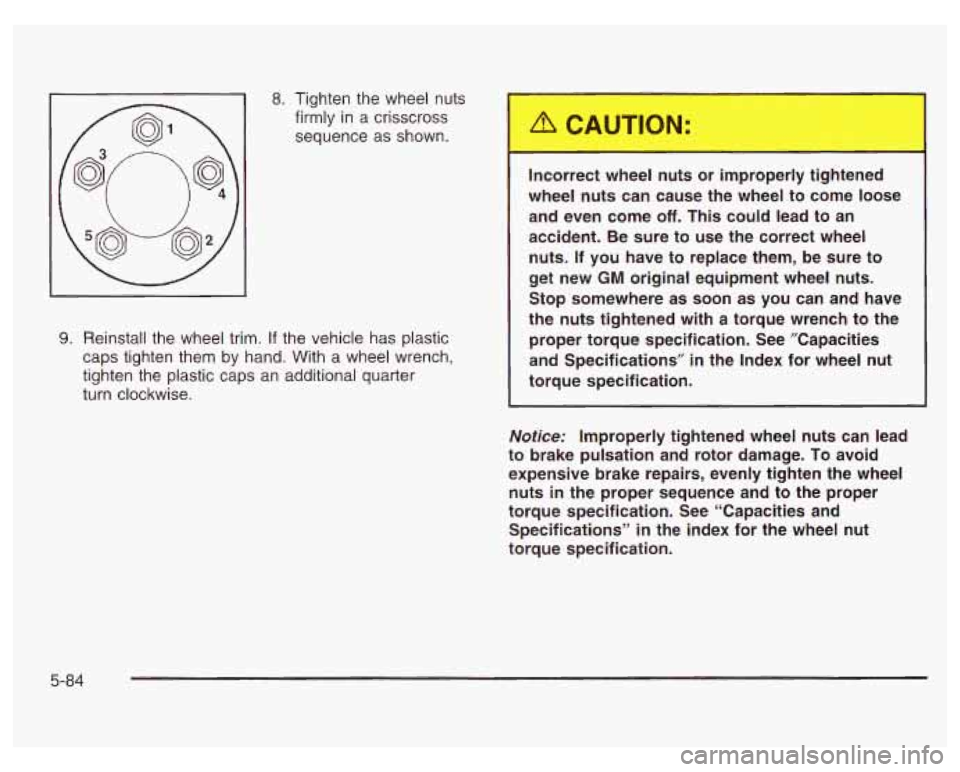
8. Tighten the wheel nuts
firmly in a crisscross
sequence
as shown.
9. Reinstall the wheel trim. If the vehicle has plastic
caps tighten them
by hand. With a wheel wrench.
tighten the plastic caps an additional quarter
turn clockwise.
I ~ ‘ect whe-- x improper tig..-med
wheel
nuts can cause the wheel to come loose
and even come
off. This could lead to an
accident. Be sure to use the correct wheel
nuts. If you have to replace them, be sure to
get new
GM original equipment wheel nuts.
Stop somewhere as soon as you can and have
the nuts tightened with
a torque wrench to the
proper torque specification. See ”Capacities
and Specifications” in the Index for wheel nut
torque specification.
Notice: Improperly tightened wheel nuts can lead
to brake pulsation and rotor damage.
To avoid
expensive brake repairs, evenly tighten the wheel
nuts in the proper sequence and to the proper
torque specification. See “Capacities and
Specifications”
in the index for the wheel nut
torque specification.
5-84
Page 310 of 378
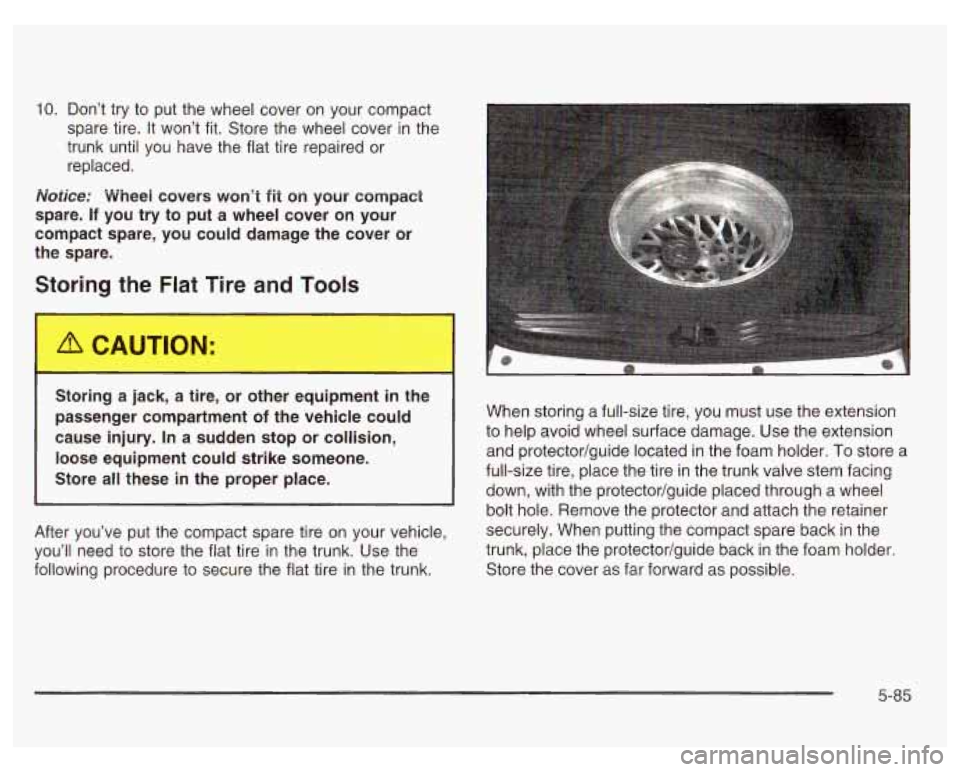
10. Don’t try to put the wheel cover on your compact
spare tire. It won’t fit. Store the wheel cover in the
trunk until you have the flat tire repaired or
replaced.
Notice: Wheei covers won’t fit on your compact
spare.
If you try to put a wheel cover on your
compact spare, you could damage the cover or
the spare.
Storing the Flat Tire and Tools
Storing a jack, a tire, or other equipment in the
passenger compartment
of the vehicle could
cause injury.
In a sudden stop or collision,
loose equipment could strike someone.
Store all these
in the proper place.
After you’ve put the compact spare tire on your vehicle,
you’ll need to store the flat tire in the trunk. Use the
following procedure to secure the flat tire in the trunk. When
storing a full-size tire, you must use the extension
to help avoid wheel surface damage. Use the extension
and protector/guide located in the foam holder.
To store a
full-size tire, place the tire in the trunk valve stem facing
down, with the protector/guide placed through a wheel
bolt hole. Remove the protector and attach the retainer
securely. When putting the compact spare back in the
trunk, place the protector/guide back
in the foam holder.
Store the cover as far forward as possible.
5-85